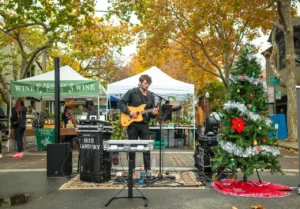After studying traditional Hmong textile arts at UC Berkeley, Pachia Lucy Vang used her free time isolating during the pandemic to develop her skills as a textile artist.

“I majored in anthropology and then I became really interested in traditional textiles,” Vang said. “I realized there was a lot about it that was really spiritual, really cultural, really historical — a lot of the Hmong identity is tied up with textiles.”
Last week, Vang was awarded a grant to help support her work as a textile artist. She was one of 200 Sacramento artists selected to receive a stipend of $850 a month over the next year through the City of Sacramento Office of Arts and Culture’s new Creative Growth Fellowship.
The goal of the $2.04 million program is to stimulate Sacramento’s creative economy by helping to support individual working artists. Applications were opened in June, and more than 800 applications were received, according to the city. Recipients were publicly announced on Sept. 5.
Melissa Cirone, grants and programs manager at the Office of Arts and Culture, said for this fellowship, the OAC wanted to support artists directly instead of issuing funds to nonprofit organizations and businesses that were doing arts programming.
“We knew that we wanted to fund individuals,” Cirone said. “We’ve known that for a long time, but we had the opportunity because of the American Rescue Plan Act funds.”
The American Rescue Plan Act (ARPA) is a federal relief bill passed in 2021 during the wake of the COVID-19 pandemic. The City of Sacramento received $112.2 million in aid from the bill. (Full disclosure: Solving Sacramento is a recipient of an ARPA-funded grant from the city.)
“Some will use [the stipend] for research, some will use it for art making, some will use it to be out in the community doing free programs,” Cirone said. “Some people will just use this money to help them live during this period while they’re doing their art.”
Another of the grantees, Chioko Juliette Grevious, directly engages with members of her community as a part of her artistic practice. She hosts a podcast called “Cocoa Butter and Communion,” where she talks with Black community members about healing generational trauma.
“Doing the work of bringing storytelling back to my community has been really important,” Grevious said. “Like the more you know about a story, if you experience adversity, you can share that forward with somebody else and that helps us all feel more free.”
Vang also finds the root of her practice in her family and culture, in the Hmong textile art called paj ntaub, or “flower cloth.” Traditional paj ntaub features intricately embroidered geometric patterns used to decorate Hmong clothing. Her work engages with Sacramento’s community through a paj ntaub circle she runs through her community design studio, Culture Through Cloth.
“We host monthly workshops in collaboration with the Hmong Center in North Sac,” Vang said. “Really, it’s a time for people to come together and just make paj ntaub.”
Vang has also been experimenting with natural, hand-foraged sources for her dyes, using flowers and berries local to the area. She’ll often go on walks in Sacramento’s Del Paso Park, gathering materials she takes to her studio. Even though she sources her pigments from Sacramento’s natural flora, her spirituality keeps her connected to Hmong culture.
“I got really into the whole idea behind the natural dyes being tied to a very spiritual, deeper aspect of what that is because we wear a lot of red and green. That symbolizes the red and green rivers that we used to live on and that we actually crossed and left when we migrated here,” Vang said. “We have all these stories of other places embedded in our clothes, but what does it mean if we start to actually look at where we are today, and think about how we can integrate parts of the land into our textiles today. “
Grevious also holds a spiritual connection to her artistic practice and heritage. She sees her role in her community as relating back to a long tradition of storytellers and poets in West African cultures.
“There’s a West African term, they’re called griots. A griot is a storyteller who shares wisdom and insight, and it can be done to music or poems or whatever,” Grevious said. “Doing the work of bringing storytelling back to my community has been really important.”
Beyond connecting on a spiritual level, sometimes the artists need to connect with community members on a more practical level. In Culture Through Cloth’s first year, they spent time teaching the basic techniques that allow someone to create paj ntaub. This year, Vang wanted to show attendees how to actually make clothes from the designs they were creating. But, they weren’t just making clothes for people.
“Last month by special request we did Labubu clothes, like Hmong clothes for Labubu,” Vang said. “But this month we’re going to be making nrhoob, which are these leg wraps that you wear with your outfit if you’re wearing a skirt and you want to wrap up your legs.”
According to the city’s press release announcing the Creative Growth Fellowship recipients, the artists’ work “spans a wide range of disciplines, including visual arts, music, theater, literary arts, craft, film, dance, design, interdisciplinary arts, oral traditions, traditional arts, performance and social practice.
Julienne Marella Villegas, another recipient of the grant, is a tattoo artist and printmaker. They regularly hold classes on risograph printing at Demo Art and Books in Sacramento. Ruben Reveles is an interdisciplinary artist who uses “digital and mixed media ethnography” to bring his futuristic ideas to life. Dakota Medina is a musician who makes music for video game soundtracks, and teaches guitar and other stringed instruments at CLARA in Sacramento.
However the grantees are connecting with their communities, the goal of the fellowship is to keep these artists in Sacramento, despite the challenges that being an artist can bring.
“In order to keep artists here in Sacramento, we want to be a city that shows how much it values its artists,” Cirone said. “Of course, there are many ways to support artists, but we think financially, it’s critical … to make sure that they continue to do their work here.”
This story was funded by the City of Sacramento’s Arts and Creative Economy Journalism Grant to Solving Sacramento. Following our journalism code of ethics and protocols, the city had no editorial influence over this story and no city official reviewed this story before it was published. Our partners include California Groundbreakers, Capital Public Radio, Hmong Daily News, Outword, Russian America Media, Sacramento Business Journal, Sacramento News & Review and Sacramento Observer. Sign up for our “Sac Art Pulse” newsletter here.
By Ruth Finch


















